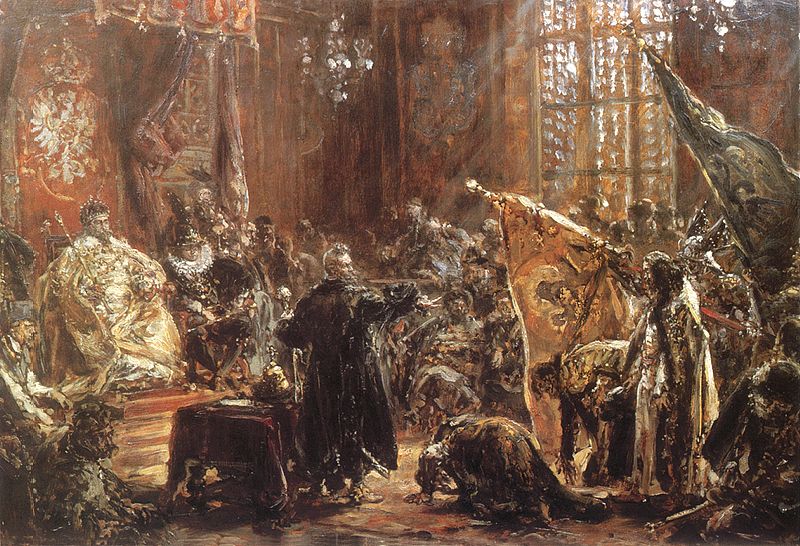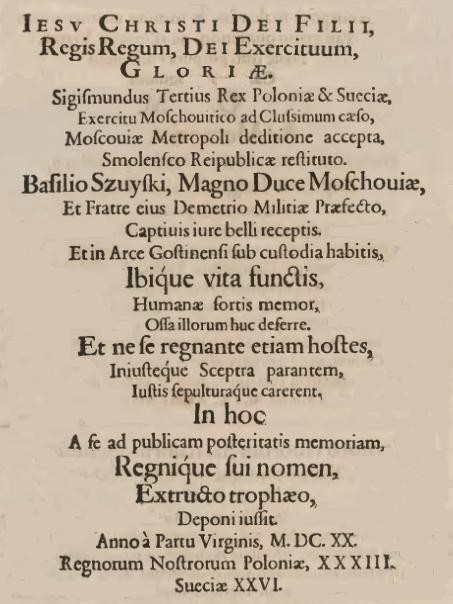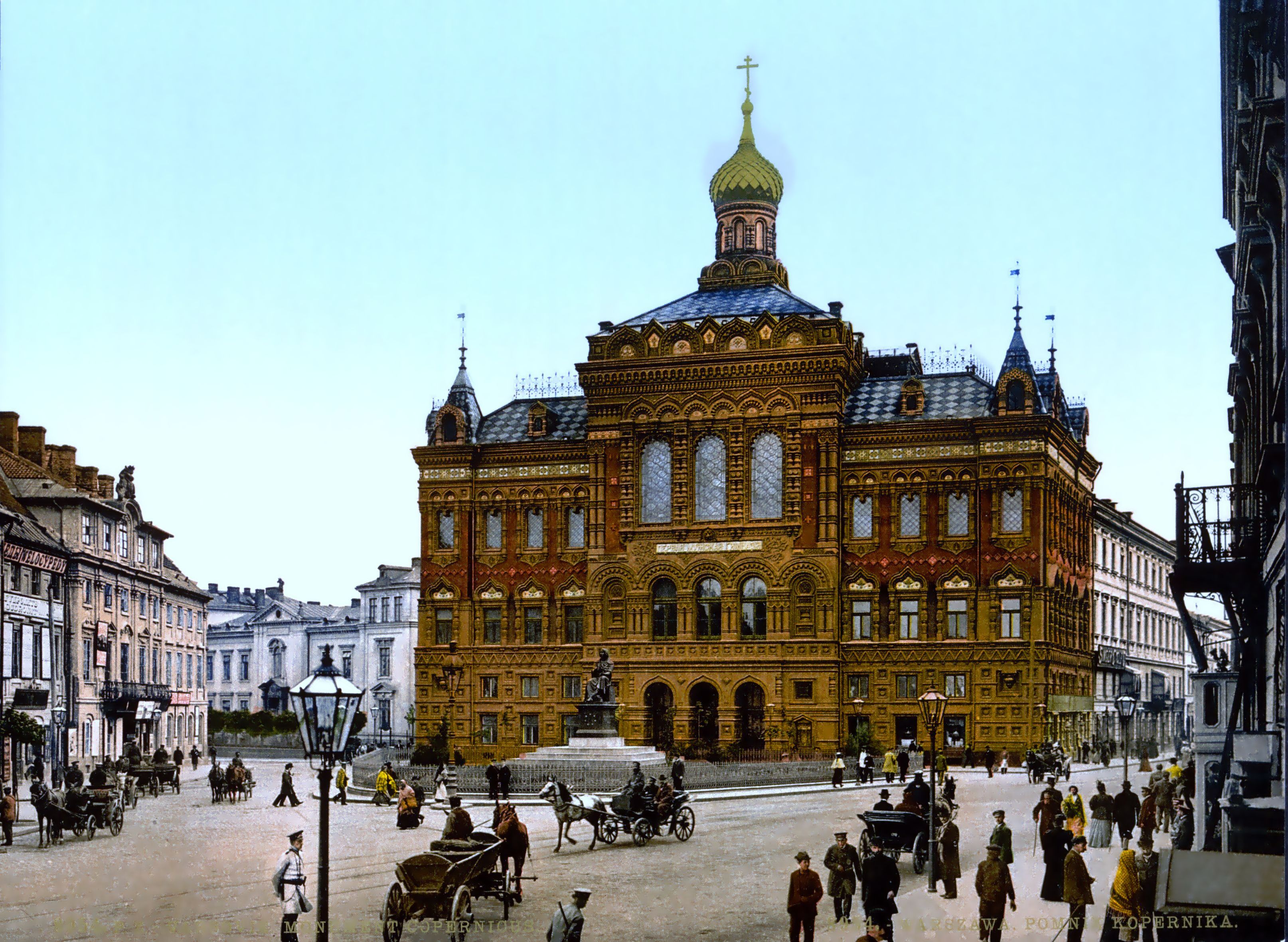Shuysky Tribute on:
[Wikipedia]
[Google]
[Amazon]



 Shuysky tribute was the act of
Shuysky tribute was the act of
 King Sigismund III Vasa built a tomb for the captive Shuysky brothers in 1620. The Chapel of Moscow in Warsaw that contained it ceased to exist around 1768. Above the entrance to the chapel was a plaque reading as follows:
King Sigismund III Vasa built a tomb for the captive Shuysky brothers in 1620. The Chapel of Moscow in Warsaw that contained it ceased to exist around 1768. Above the entrance to the chapel was a plaque reading as follows:
 The only indirect commemoration of the success of King Sigismund III is a western plaque text in Latin located on Sigismund's column.
The only indirect commemoration of the success of King Sigismund III is a western plaque text in Latin located on Sigismund's column.

''Oddanie tryumfalne Wasilia Szuyskiego Cara Moskiewskiego, i z bracią Jego królewskiey Mości na seymie w Warszawie, przez hetmana koronnego P. Stanisława Żółkiewskiego, który woyska wielke Moskiewskie pod Kluzinem poraziwszy, stolicę Moskiewską spaliwszy, Cara tego poimał. ''
''Z rękopisu biblioteki X.A.C.''
http://www.wbc.poznan.pl/dlibra/publication?id=90940&tab=3]. "Pamiętnik lwowski". t. 1 nr 3 – 3/4 (I), s. 1-6, 1818. * Julian Ursyn Niemcewicz: ''Dzieje panowania Zygmunta III''. 1836. * Janusz Byliński: ''Sejm z roku 1611''. Wrocław: Zakład Narodowy im. Ossolińskich, 1970, s. 246. * Antoni Prochaska:
Hetman Stanisław Żółkiewski
'. Warszawa: 1927, s. 419. * Wacław Sobieski:
Żółkiewski na Kremlu
'. Warszawa: Gebethner i Wolff, 1925, s. 217. * Andrzej Chojnowski, Halina Manikowska: ''Historia''. Warszawa: 1995, s. 189-190, seria: Vademecum maturzysty. * {{citation, url = http://tygodnik.onet.pl/35,0,68310,hold_ruski,artykul.html, title = Hołd ruski, date= 2011-10-22, author = Adam Węgłowski 1611 in Russia 1611 in the Polish–Lithuanian Commonwealth Poland–Russia relations



 Shuysky tribute was the act of
Shuysky tribute was the act of homage
Homage (Old English) or Hommage (French) may refer to:
History
*Homage (feudal) /ˈhɒmɪdʒ/, the medieval oath of allegiance
*Commendation ceremony, medieval homage ceremony Arts
*Homage (arts) /oʊˈmɑʒ/, an allusion or imitation by one arti ...
of the deposed Mickail Shuysky
The Princes Shuisky (russian: Шуйские, Shuyskiye) was a Rurikid family of Boyars descending from Grand Duke Dimitri Konstantinovich of Vladimir-Suzdal and Prince Andrey Yaroslavich, brother to Alexander Nevsky. The surname is derived f ...
of Russia and his retinue to the Polish King Sigismund III Vasa
Sigismund III Vasa ( pl, Zygmunt III Waza, lt, Žygimantas Vaza; 20 June 1566 – 30 April 1632
N.S.) was King of Poland and Grand Duke of Lithuania from 1587 to 1632 and, as Sigismund, King of Sweden and Grand Duke of Finland from 1592 to ...
and teenage prince Władysław (the then-candidate to the Russian throne) on October 29, 1611, in the Senate Hall of the Royal Castle in Warsaw
Warsaw ( pl, Warszawa, ), officially the Capital City of Warsaw,, abbreviation: ''m.st. Warszawa'' is the capital and largest city of Poland. The metropolis stands on the River Vistula in east-central Poland, and its population is officiall ...
.
Hetman
( uk, гетьман, translit=het'man) is a political title from Central and Eastern Europe, historically assigned to military commanders.
Used by the Czechs in Bohemia since the 15th century. It was the title of the second-highest military ...
of the Crown Stanisław Żółkiewski, who had captured Moscow the previous year, held a victory procession to the Royal Palace through the city of Warsaw, leading with him the prisoners: the former Russian tsar Vasily IV Shuysky, his two brothers Ivan and Dmitry
Dmitri (russian: Дми́трий); Church Slavic form: Dimitry or Dimitri (); ancient Russian forms: D'mitriy or Dmitr ( or ) is a male given name common in Orthodox Christian culture, the Russian version of Greek Demetrios (Δημήτρι� ...
, the wife of the latter, Grand Duchess Ekaterina Grigoryevna (a daughter of Ivan the Terrible
Ivan IV Vasilyevich (russian: Ива́н Васи́льевич; 25 August 1530 – ), commonly known in English as Ivan the Terrible, was the grand prince of Moscow from 1533 to 1547 and the first Tsar of all Russia from 1547 to 1584.
Iva ...
's associate Malyuta Skuratov and sister of a former tsarina, the spouse of Tsar Boris Godunov
Borís Fyodorovich Godunóv (; russian: Борис Фёдорович Годунов; 1552 ) ruled the Tsardom of Russia as ''de facto'' regent from c. 1585 to 1598 and then as the first non-Rurikid tsar from 1598 to 1605. After the end of his ...
), military commander Mikhail Shein
Mikhail Borisovich Shein (Михаил Борисович Шеин, ) (late 1570s–1634) was a leading Russian general during the reign of Tsar Mikhail Romanov. Despite his tactical skills and successful military career, he ended up losing his ar ...
, and Patriarch Filaret who would ascend to power in Russia later on as the father and ''de facto'' ruler behind the back of his son Michael I of Russia
Michael I ( Russian: Михаил Фёдорович Романов, ''Mikhaíl Fyódorovich Románov'') () became the first Russian tsar of the House of Romanov after the Zemskiy Sobor of 1613 elected him to rule the Tsardom of Russia.
He ...
, the founder of the Romanov Dynasty
The House of Romanov (also transcribed Romanoff; rus, Романовы, Románovy, rɐˈmanəvɨ) was the reigning imperial house of Russia from 1613 to 1917. They achieved prominence after the Tsarina, Anastasia Romanova, was married to ...
.
Background
The internal and external policies ofIvan the Terrible
Ivan IV Vasilyevich (russian: Ива́н Васи́льевич; 25 August 1530 – ), commonly known in English as Ivan the Terrible, was the grand prince of Moscow from 1533 to 1547 and the first Tsar of all Russia from 1547 to 1584.
Iva ...
led to a lasting power crisis that also extinguished the direct line of the Rurikids
The Rurik dynasty ( be, Ру́рыкавічы, Rúrykavichy; russian: Рю́риковичи, Ryúrikovichi, ; uk, Рю́риковичі, Riúrykovychi, ; literally "sons/scions of Rurik"), also known as the Rurikid dynasty or Rurikids, was ...
early on. Sigismund III saw this as an opportunity to conclude a personal union with Moscow. He hoped that after uniting Polish and Russian forces he could successfully compete for the Swedish crown. The staunchly Catholic King of Poland was supported in his ambition by Pope Clement VIII
Pope Clement VIII ( la, Clemens VIII; it, Clemente VIII; 24 February 1536 – 3 March 1605), born Ippolito Aldobrandini, was head of the Catholic Church and ruler of the Papal States from 2 February 1592 to his death in March 1605.
Born ...
, who hoped to increase his influence over the Russian Orthodox Church
, native_name_lang = ru
, image = Moscow July 2011-7a.jpg
, imagewidth =
, alt =
, caption = Cathedral of Christ the Saviour in Moscow, Russia
, abbreviation = ROC
, type ...
. After Sigismund III's negotiations with Moscow proved unsuccessful, the Poles invaded Russia in 1604 and took Moscow, introducing Sigismund III's protege, False Dmitry, to the throne.
In 1606 in Moscow an anti-Polish uprising broke out, headed by Vasily Shuysky. After the mob killed False Dmitry and massacred foreigners, Vasily Shuisky was elected tsar, and in 1608 signed a truce with the Polish king. However, fearing Poland and the lack of his subjects' support, he concluded a pact of alliance with Sweden. This event became the pretext for yet another Polish expedition to Russia.
On June 24, 1610, the Russian forces suffered their major defeat in the Battle of Klushino, mainly due to the mismanagement of Dmitry Shuysky. On June 27, the group of Seven Boyars deposed Tsar Vasily and made him a monk against his will to ensure his political death. In September 1610, the Seven Boyars, who now constituted the provisional government, handed Vasily and other members of the Russian royalty over to the Polish forces.
A year later, on October 29, 1611, Hetman Żółkiewski, in a solemn procession, marched his army into Warsaw bringing Vasily Shuysky and his brothers Dmitry and Ivan with him. In the presence of the nobility and the Senate they gave the oath of allegiance to King Sigismund III Vasa.
Monuments and paintings
The place of Shuysky Tribute today (2011) does not carry any special inscription neither in the Royal Castle of Warsaw nor in the city of Warsaw. Trophies and other material objects brought over with Shuysky were consistently removed and destroyed in the name of Russian raison d'etat.Paintings
Two large paintings by Tommaso Dolabella, of Tsar Vasili IV Shuysky paying homage to Sigismund III, and of the Polish capture of Smolensk, were looted by the Russian army in 1707 when the Royal Castle in Warsaw was captured by Tsar Peter I. According to another version of the images (ceilings from the floor of the Senate) they gave King August II insistent requests in 1716. Tsar Peter I still believed to be missing. One of the missing paintings by Tommaso Dolabella to pay homage to Sigismund III by Vasili IV is a known engraving of Tomasz Makowski and copies or other recognized tribute from Vasili IV the image coming from collections in the castle Pidhirtsi. Shuyskys tribute tsars became the subject of the picture John Cantius Szwedkowsky and two paintings ofJan Matejko
Jan Alojzy Matejko (; also known as Jan Mateyko; 24 June 1838 – 1 November 1893) was a Polish painter, a leading 19th-century exponent of history painting, known for depicting nodal events from Polish history. His works include large scale ...
- youth of 1853 and the sketch to the image, which the artist could not paint.
Chapel of Moscow – the tomb of Vasili IV
Plaque on Sigismund's column
 The only indirect commemoration of the success of King Sigismund III is a western plaque text in Latin located on Sigismund's column.
The only indirect commemoration of the success of King Sigismund III is a western plaque text in Latin located on Sigismund's column.

Request a pretext Russia's rulers terms of Polish kings
Iconography tribute Szujskich, descriptions of the event and the Chapel of Moscow were the pretexts of a number of demands made by the following representatives of the Romanov dynasty rulers of the Republic in the seventeenth and eighteenth centuries. Tsar Vasily IV Shuysky remained in Polish captivity after his dethronement July 17, 1610, at the time the Czar of Moscow and all was Prince Ladislaus IV Vasa. Still, Chapel Moscow and other items documenting stay in the Republic tsar Wasyl IV Shuysky and his family were "salt in the eye," later rulers of the Romanov dynasty. In times of Tsar Michael I Romanov page Moscow started negotiations to recover the bodies of Tsar Vassily IV Shuysky and his family. After the peace in Polanów the bodies of the Tsar, his brother, and Princess Yekaterina Russia were released in 1635. In 1647 the Tsar Alexei Romanov I received a request hand of Moscow, the Moscow to demolish the chapel, but the king Ladislaus IV refused, passing that it can return an array headstone. Subsequent requests related descriptions Polish triumph. Anyone who described the tribute to Tsar Shausky in the Parliament of the Republic could expect that Mr requested by the burning of Moscow and head writer works as redress insults tsarist majesty. In 1678 during the reign of KingJohn III Sobieski
John III Sobieski ( pl, Jan III Sobieski; lt, Jonas III Sobieskis; la, Ioannes III Sobiscius; 17 August 1629 – 17 June 1696) was King of Poland and Grand Duke of Lithuania from 1674 until his death in 1696.
Born into Polish nobility, Sobi ...
he received a request Tsar Fedor Romanov for the issuance of two paintings by Tommaso Dolabella from the Royal Palace depicting a tribute to Tsar Vassily Shuysky with his brothers Dmitri and Ivan called Russian. Pugowka (pol. Button) before King Sigismund III Vasa, as abusive tsarist majesty. Requests it has and these images that are believed to still be missing, handed Tsar Peter I King August II the Strong
Augustus II; german: August der Starke; lt, Augustas II; in Saxony also known as Frederick Augustus I – Friedrich August I (12 May 16701 February 1733), most commonly known as Augustus the Strong, was Elector of Saxony from 1694 as well as Ki ...
.
In the period between the years 1764-1768, with the recommendation Russian envoy Nikolai Repnin excavated and preserved destroyed an array of Chapel of Moscow foundation of King Zygmunt III Vasa.
In the years 1892-1895, at the time of the Russian occupation, on the initiative of Alexander Apuchtina rebuilt Palace of Science and Technology in the Byzantine-Ruthenia
Ruthenia or , uk, Рутенія, translit=Rutenia or uk, Русь, translit=Rus, label=none, pl, Ruś, be, Рутэнія, Русь, russian: Рутения, Русь is an exonym, originally used in Medieval Latin as one of several terms ...
n style, designed by Russian architect Vladimir Pokrovsky and established in the building of the palace church of St. Tatiana of Rome in order to destroy the architecture Corazzi and that "... forever in the memory of Poles bury memories of previous Polish building, thought and effort of Science and Technology built ..." - the pretext was the alleged existence at this point of the Moscow Chapel with the tomb of Tsar Vassily Shuysky.
In 1954 in the communist era the eighteenth-century rotunda was dismantled. Street. Swietokrzyska 1 due to the recognition of her before 1939 for the remains of the Chapel of Moscow.
Bibliography
''Oddanie tryumfalne Wasilia Szuyskiego Cara Moskiewskiego, i z bracią Jego królewskiey Mości na seymie w Warszawie, przez hetmana koronnego P. Stanisława Żółkiewskiego, który woyska wielke Moskiewskie pod Kluzinem poraziwszy, stolicę Moskiewską spaliwszy, Cara tego poimał. ''
''Z rękopisu biblioteki X.A.C.''
http://www.wbc.poznan.pl/dlibra/publication?id=90940&tab=3]. "Pamiętnik lwowski". t. 1 nr 3 – 3/4 (I), s. 1-6, 1818. * Julian Ursyn Niemcewicz: ''Dzieje panowania Zygmunta III''. 1836. * Janusz Byliński: ''Sejm z roku 1611''. Wrocław: Zakład Narodowy im. Ossolińskich, 1970, s. 246. * Antoni Prochaska:
Hetman Stanisław Żółkiewski
'. Warszawa: 1927, s. 419. * Wacław Sobieski:
Żółkiewski na Kremlu
'. Warszawa: Gebethner i Wolff, 1925, s. 217. * Andrzej Chojnowski, Halina Manikowska: ''Historia''. Warszawa: 1995, s. 189-190, seria: Vademecum maturzysty. * {{citation, url = http://tygodnik.onet.pl/35,0,68310,hold_ruski,artykul.html, title = Hołd ruski, date= 2011-10-22, author = Adam Węgłowski 1611 in Russia 1611 in the Polish–Lithuanian Commonwealth Poland–Russia relations